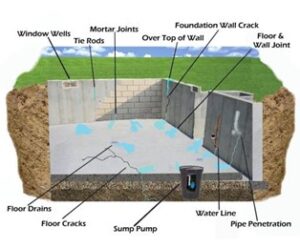Spring Flooding

As we head into spring, thoughts of burst pipes and ice dams will fade away, but all may not be sunny and dry. This spring you need to be aware of flooding caused by heavy rains and rapid snow melt. Water can enter our homes in several ways: surface water can flow over or penetrate the foundation, rising ground water can penetrate floors and foundation walls, storm water can back up sewer and drain lines pushing water and waste into your home, and existing pump systems can fail when you need them most.
If you do experience flooding, it’s important to protect your building and personal property. Before disaster strikes, however, there are steps you can take to understand your risk and potentially avoid the disaster altogether.
Surface Water
How water flows and collects on your property is critical to understanding your risk of flooding from surface water. Ideally, you want water to flow away from your home. Grading, swales, drain lines and gutter extensions can all be useful tools to keep water away from the foundation. Water that pools next to the foundation will exert pressure on the foundation. Any cracks or gaps will provide an entry path for the water. A common entry point is the gap between the slab and the foundation walls. The image below depicts many possible entry points. Ice and snow can also create temporary dams that allow water to pool against the foundation. Walk your property and evaluate the risk. If you have ice dams, cut a trench to prevent water back up. If you don’t mind getting wet, put on some boots and walk your property during a period of heavy rains and observe the water flow. You may identify problems that can be easily corrected. If you cannot keep the water away you may need a mitigation system. There are many companies that provide these systems and can also help assess your flood risk.

Ground Water
A rising water table can wreak havoc with your basement. Water tables are dynamic. Some parts of the country are running out of water due to prolonged drought and over-pumping. Fortunately, we have plenty of water in the Northeast. Unfortunately, a rising water table can cause water to flow into your basement. We have seen cases where high water has created an artesian well in a basement floor. If you do have a high water table your options are limited. The best approach is to put a mitigation system in place that locally depresses the water table. This is usually a subfloor drain system with one or more collection points for pump out.
One caveat with a pump system is power. Powerful storms that cause flooding can oftentimes take out power. If you are relying on a pump system to keep your basement dry you should also consider a backup power supply. Ideally this should have an automatic transfer switch to keep the pump running if you are away.
Backups
Like ground water, backups due to excess water getting into the sewer system are difficult to control. Backflow preventers can be installed to help prevent back flow. If you do experience a sewer backup you need to be cautious with the cleanup due to potential health issues.
As in all cases involving water damage, prevention is the key. Taking the necessary steps just outlined will help prevent a larger water emergency disaster.
